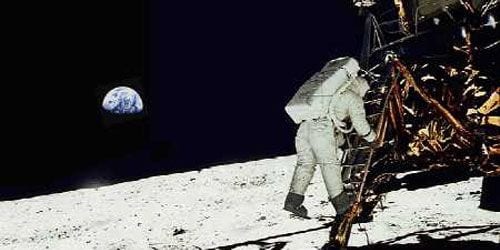
The Apollo 11 moon landing is one of the defining moments of the 20th century, and the countless documentaries covering it only cement that reputation. Does unseen footage remain that could enhance our understanding?
We’ve already had such releases as Men on the Moon, The Eagle Has Landed, Journey to the Moon and others specifically targeting the first moon landing. Not to mention classic documentaries like In the Shadow of the Moon and For All Mankind that offered a broad perspective on the Apollo program. It’s a subject that reveals a wealth of possibilities, but even those paths seem well-traveled.
Originally airing in February 2006 on BBC Four, Apollo 11: A Night to Remember compiles rarely seen BBC footage from the pivotal event with present-day comments from Astronomist Sir Peter Moore. The Sky at Night television film is now being released to coincide with the 40th anniversary of the Apollo 11 landing.
Sporting an old-style monocle and ill-fitting suit while sitting in front of an old typewriter, Moore can’t help but elicit a laugh from modern audiences. His resume is unparalleled in this field, but the choice to shoot unflattering close-ups of him doesn’t help the material. Moore ends up resembling a caricature of a stuffy British academic instead of a passionate Apollo expert.
After Moore’s introduction, the picture’s first half actually moves fairly well and includes some brilliant comic interludes from James Burke. Originally shown as informational pieces to complement the Apollo 11 coverage, they inject much-needed fun into the presentation. With his thick glasses and minimal build, Burke embodies the whimsical science guy perfectly. He’s the British Bill Nye for space aficionados.
The first interlude sends him into the astronauts’ safety room, which rests below the launch pad. Designed in case of a Saturn rocket explosion, this area contains giant lounge chairs plus enough food for 20 people to survive for 24 hours. Sliding into the room and demonstrating its quirky set-up, Burke quickly reveals his divergence from the typical newsman.
Burke’s other segments raises the stakes, sending him into the “vomit comet” and demonstrating the EVA space suit. The latter scene involves a look at each aspect of the suit before they’re discarded. Watching several people struggle to lift the space suit over Burke’s head is a great moment. He even discusses the goofy astronaut underwear before jumping in the shower to sing a tune.
Burke’s infectious energy permeates each scene and seems fairly genuine. Aboard the “vomit comet”, his enjoyment of weightlessness feels surprisingly natural. A well-known science historian in Britain, Burke may be a revelation to other audiences.
The film’s second half offers a linear take on Apollo 11 with a little background from Moore. The grainy and often shaky video depicting mission control and the astronauts plods along deliberately. The vintage BBC material should jump off the screen and inspire us, but the footage just sits there.
I’ve read numerous books covering Apollo and usually love this type of documentary. Unfortunately, even the shots from inside the spacecraft are just mildly affecting. Some portions are nearly unwatchable and just give us blurry shots of the consoles. This video appears designed solely for completists who need to own every Apollo 11 retrospective.
When the picture finally reaches Neil Armstrong’s seminal moment, we’re ready for the ending credits. Even a silly appearance from Richard Nixon does little to alleviate the tedium. Speaking to Armstrong and Buzz Aldrin by telephone, he appears on screen in a little circle out in space and looks even more ridiculous than usual.
The final moments show the astronauts taking soil samples and trotting along near their ship. The clear shots from above them are impressive but could have used more historical background. Director Paul Vanezis employs a detached approach and wisely avoids overdramatizing Apollo 11. However, his style veers too far in the other direction and completely removes the emotional force. This landing was a world-changing moment, which makes the sedate tone a major disappointment.
Apollo 11: A Night to Remember also includes text giving Moore’s biography and an episode of The Sky at Night from September 1960. The 15-minute feature presents images of the dark side of the moon taken by the Russian Lunik 3 craft. Moore hosts and conveys his tremendous knowledge of the moon while inspecting the photos. He’s actually led the series for more than 50 years, beginning in April 1957.
This material is pretty dry even while viewing the impressive pictures. It should interest astronomers and Apollo experts, but everyone else may feel lost amid the technical details.

![Call for Papers: All Things Reconsidered [MUSIC] May-August 2024](https://www.popmatters.com/wp-content/uploads/2024/04/all-things-reconsidered-call-music-may-2024-720x380.jpg)



